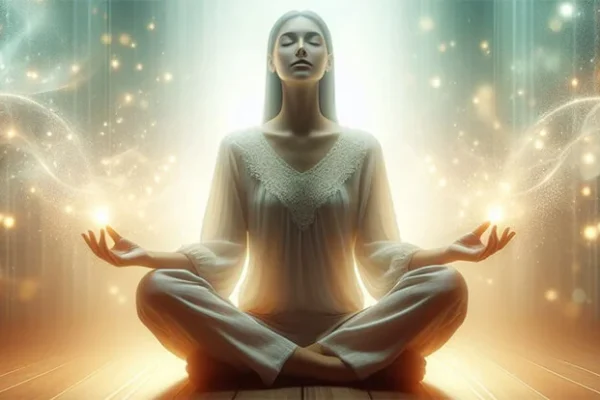LED backlighting for TVs has become an integral part of modern home interiors. It not only enhances the visual perception of the screen but also makes the room cozier. This design element has gained popularity due to its versatility, affordability, and ability to seamlessly integrate into any setting. Users can choose from various lighting modes—ranging from soft white light to bright, vibrant colors that dynamically change depending on the content being played.
Many appreciate LED backlighting for its functionality: it helps reduce eye strain when watching TV in the dark by creating a comfortable glow around the screen. Moreover, such lighting can serve as a decorative accent that sets the mood and enhances the ambiance.
But its influence goes beyond mere decoration or convenience. A deeper question arises: how do the light and colors emitted by LED backlighting affect our emotional state?
Color and light play a crucial role in our lives. Color psychology suggests that each shade evokes specific emotional reactions:
- Warm tones (yellow, orange, red) are associated with energy, warmth, and joy, but in excess, they may cause feelings of anxiety or tension.
- Cool shades (blue, purple, green) promote relaxation, creating a sense of calm and tranquility.
- Neutral colors (white, gray) help with focus, providing a setting for comfortable information processing.
The light accompanying these colors amplifies their effects. Soft lighting helps with relaxation, while bright, dynamic light can stimulate brain activity. LED backlighting, offering a wide range of shades and modes, allows for experimenting with these effects, tailoring the atmosphere to personal needs.
It is especially important to consider that in the context of a TV, where a bright screen often contrasts with dim room lighting, backlighting can act as a mood-regulating tool. For instance, blue or green light can reduce stress after a tough day, while dynamic color transitions heighten emotional engagement in movies or video games.
Thus, the popularity of LED backlighting for TVs is explained not only by its aesthetic and practical benefits but also by its ability to positively influence psychological well-being, creating harmony at home.
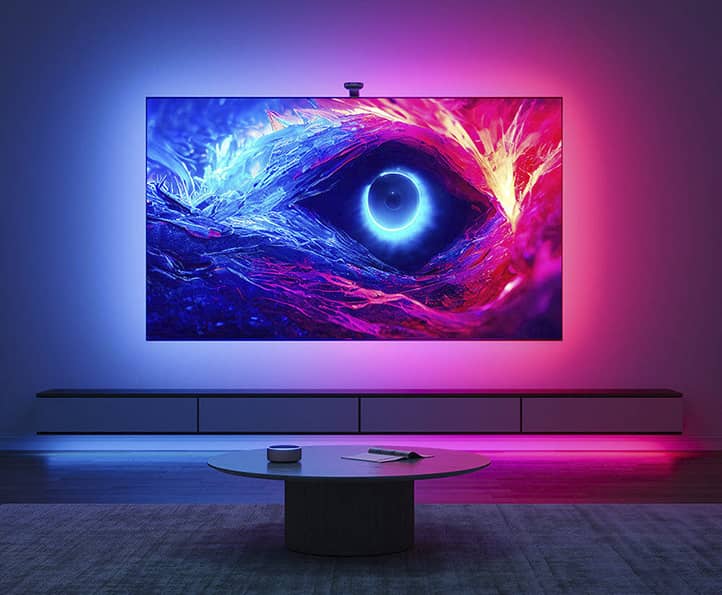
How Do Light and Color Affect the Psyche?
Light and color are not just physical phenomena but also powerful tools that influence our perception and emotional state. The human brain processes light signals through the visual system, engaging not only the organs of sight but also the psyche. Colors and the intensity of lighting can evoke a wide range of emotions – from calmness to excitement, from joy to anxiety. This is why lighting design, including LED backlighting for TVs, plays a key role in creating a home atmosphere and impacting psychological well-being.
Numerous studies confirm that light affects the brain by stimulating different areas associated with emotional responses. For example, warm colors can evoke feelings of coziness and comfort, while cool tones often promote relaxation. Lighting is crucial not only for setting the mood but also for overall well-being: proper lighting can reduce stress, improve focus, or even influence sleep.
Let’s take a closer look at two key aspects—the psychological perception of color and the role of lighting in creating emotional comfort.
Psychological Perception of Color and Its Impact on Mood
Color is one of the most important stimuli for the brain, capable of triggering complex emotional and cognitive processes. Each shade evokes specific associations, often tied to natural or cultural influences. Here’s how some primary colors affect the psyche:
- Red: Associated with energy and passion, but prolonged exposure may heighten arousal or even provoke aggression.
- Yellow: A color of joy and warmth, it stimulates creativity but can cause anxiety if overused.
- Blue: Calms the mind, reduces stress, and aids concentration.
- Green: Evokes a sense of harmony and tranquility, often associated with nature and relaxation.
- Purple: Inspires and enhances intuition but may create a sense of mystery or detachment.
Color perception is closely tied to cultural and individual differences. For instance, in Eastern cultures, white often symbolizes mourning, while in Western countries, it represents purity and freshness. LED backlighting for TVs allows users to consider these nuances by selecting shades that match personal preferences and goals.
The Role of Lighting in Creating Emotional Comfort
The intensity and type of light are just as important as its color. Soft, even lighting promotes relaxation, while sharp, bright flashes can irritate and heighten anxiety levels.
- Soft light: Reduces eye strain and creates a cozy atmosphere. LED backlighting with adjustable brightness is ideal for watching TV in the dark.
- Bright light: Stimulates activity and focus. Suitable for gaming or dynamic movies, but excessive brightness should be avoided to prevent eye fatigue.
- Flickering light: Can cause discomfort or even headaches. It’s recommended to use high-quality LED systems that provide stable illumination.
Lighting directly influences circadian rhythms—our internal biological clock. Bright, cool light can suppress melatonin production, promoting alertness, while warm, soft light fosters relaxation and prepares the body for rest. LED backlighting enables the adjustment of lighting to meet specific needs, offering a stimulating effect in the morning or a calming effect in the evening.
As we can see, the choice of color and lighting plays a significant role in creating emotional comfort. Using LED backlighting for TVs not only enhances the aesthetics of a space but also improves mood, reduces stress, and helps maintain a balance between activity and relaxation.
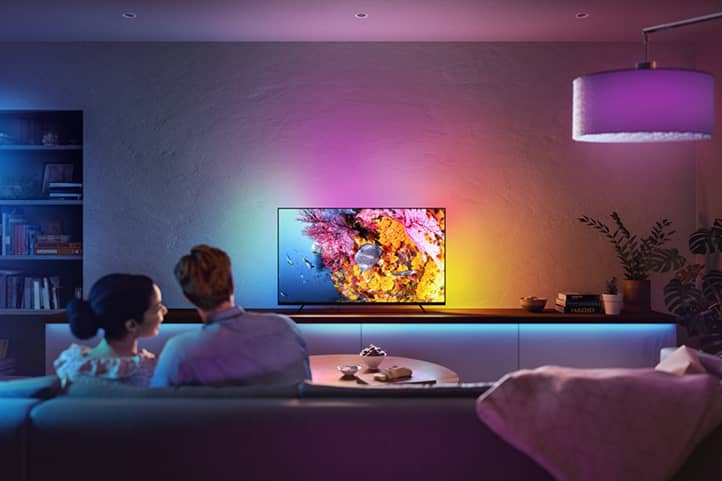
Color and Emotions: What Does Science Say?
Colors play a significant role in our lives, influencing the psyche and shaping emotional responses. Scientific research confirms that color perception is closely linked to biological and psychological mechanisms. Different shades can evoke feelings of calm, excitement, joy, or anxiety, making them a powerful tool for creating mood and atmosphere.
LED lighting, offering a wide range of shades, allows for experimenting with emotional effects, enhancing immersion in movies or TV shows. Light and color combine to impact the viewer, amplifying the emotions embedded in a cinematic work. For example, red accents can emphasize tension, while soft blue tones heighten melancholy.
Let’s explore how different shades influence emotions and why the right lighting choice can enhance the viewing experience.
Effects of Different Tones
Warm tones are associated with coziness, safety, and happiness. They evoke memories of sunsets, fire, or warm sunlight, bringing a sense of comfort.
- Yellow: Stimulates the brain, evoking joy and improving mood. Often linked to creativity, it is helpful for watching inspiring or light-hearted films. However, overly bright yellow may cause irritation.
- Orange: Has a warming effect, promotes relaxation, and helps relieve stress. It is often used to create a laid-back atmosphere, perfect for romantic or family movies.
LED lighting with warm tones helps create a cozy corner for relaxation, enhancing unwinding and relieving tension after a busy day.
Cool tones are associated with calmness and intellectual focus. They remind us of nature — the night sky, water, glaciers — helping us escape the hustle and bustle.
- Blue: Reduces stress levels and aids concentration. Ideal for deep, dramatic films where immersion in the storyline is crucial.
- Purple: Stimulates imagination and heightens a sense of mystery. This shade is suitable for thrillers, sci-fi, or fantasy genres.
Using cool colors in lighting helps viewers focus on film details and enhances the sense of presence.
Muted tones create a soft, unobtrusive atmosphere conducive to relaxation.
- White: Symbolizes purity and tranquility. It can be a basic choice for watching films of any genre, especially when emotional emphasis is unnecessary.
- Pastel and Gray Tones: Aid relaxation without distracting attention. These colors are perfect for movies where maintaining a neutral emotional background is essential.
Muted tones in LED lighting create a calm atmosphere, helping viewers disconnect from daily worries and simply enjoy the film.
How Colors Enhance the Experience of Watching Movies and TV Shows?
The colors surrounding the viewer play a key role in their perception of the content. For example, if a movie scene is filled with warm shades, matching lighting enhances the effect, creating a sense of full immersion.
- For dramas and thrillers: Cool tones like blue or purple emphasize tension and amplify the emotional impact of the storyline.
- For comedies and family movies: Warm and soft shades add coziness and relaxation, helping viewers feel joy and comfort.
- For fantasy and sci-fi: Bright and unusual colors like vibrant green or purple heighten the sense of magic and uniqueness in the story.
LED lighting not only creates a beautiful visual effect but also becomes an essential element of emotional perception. Using light, you can turn watching a movie into not just entertainment but a profound immersion into another reality.
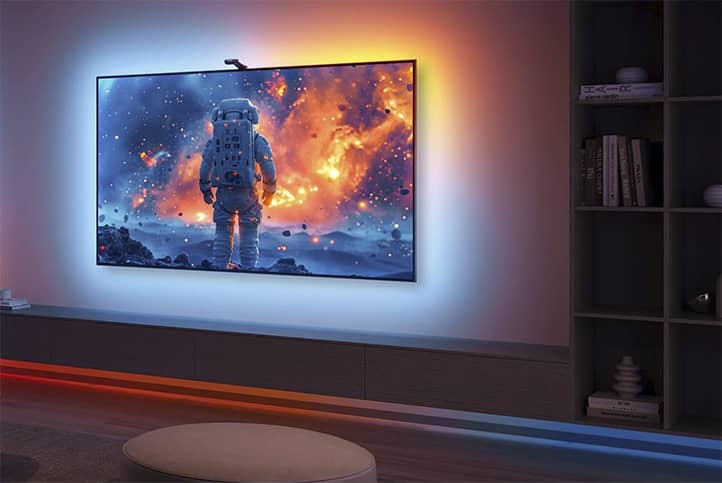
LED Backlighting for TVs in the Context of Psychotherapy and Relaxation
The use of light as a tool for improving mental and emotional well-being has a long history. In psychotherapy, light is used to regulate mood, combat seasonal depression, and create a relaxing atmosphere. LED backlighting for TVs, with its extensive customization options for color and intensity, is becoming an increasingly popular tool for home use to promote relaxation and harmonize spaces.
Lighting technologies, including LED, have distinct advantages: they are energy-efficient, safe for the eyes, and offer a broad spectrum of shades. This makes it possible to create an environment that is not only aesthetically pleasing but also supportive of emotional health. With easy adjustability, such systems are ideal for home use, helping to organize spaces for relaxation or meditation.
Let’s explore how LED backlighting aligns with the principles of light therapy and consider psychologists’ recommendations for its use in creating a harmonious atmosphere.
Light Therapy: Similarities to LED Backlighting
Light therapy is a treatment method based on exposure to light of specific wavelengths. It is often used to address seasonal affective disorder, sleep disturbances, and even chronic fatigue syndrome. Its principle of operation involves stimulating serotonin production (the “happiness hormone”) and suppressing melatonin (the “sleep hormone”), thereby improving mood and increasing alertness.
While LED backlighting cannot replace full-fledged light therapy, it offers some similar effects:
- Mood Regulation: Choosing warm or cool shades helps manage emotional states. For example, soft warm light soothes, while cool light stimulates activity.
- Biological Rhythm Stimulation: LED systems with adjustable intensity and color temperature can mimic the natural daily light cycle. This is especially beneficial for people who lack sunlight exposure.
- Support for Relaxation: Dimmed lighting helps reduce stress and tension, creating a sense of safety and comfort.
Thus, incorporating LED backlighting into home practices can contribute to improved psychological well-being.
Psychologists’ Recommendations for Creating a Harmonious Environment
Psychologists emphasize that proper lighting plays a key role in fostering a cozy and relaxing atmosphere. Both color and light intensity are crucial factors to consider.
- Creating Zones with Different Lighting: Experts recommend using LED backlighting to delineate functional areas. For example, bright light can be applied in work zones, while soft warm light is ideal for relaxation areas. This helps visually separate spaces and supports proper perception.
- Adjusting Shades to Match Moods: Warm colors such as yellow and orange help relieve tension and unwind after a hard day. Cool tones like blue are recommended for meditation and concentration.
- Avoiding Harsh Contrasts: Excessively bright or abrupt transitions between lighting zones can cause discomfort. LED backlighting with smooth color transitions prevents this.
Additionally, specialists suggest using dynamic lighting modes, such as gradual dimming or color changes. This creates the effect of living light, which fosters relaxation and tranquility.
Example of Using LED Backlighting for Relaxation
Suppose you want to create an evening relaxation zone. Psychologists advise choosing dim yellow or orange light, setting it to low brightness, and incorporating gentle transitions between shades. If the goal is preparation for meditation, cool blue or green light can help focus and promote calmness.
LED backlighting, integrated into your home environment, becomes more than just a design element — it’s a vital part of your psychological comfort. When used thoughtfully, it can significantly enhance quality of life by creating a space for rest and recovery.
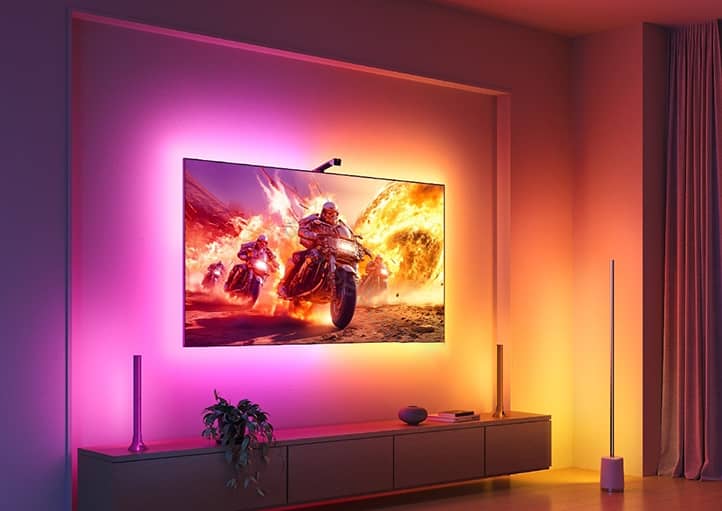
Practical Tips for Choosing and Adjusting LED Backlighting
The right choice of backlighting and its proper adjustment can significantly enhance your TV experience and create a cozy atmosphere in the room.
When selecting backlighting, it’s important to consider the size of the TV, preferred light shades, and the intended purposes — whether for relaxation, immersive movie watching, or active gaming.
Learning how to properly adjust the color and brightness is equally important to ensure the light isn’t too intense or irritating to the eyes. Let’s explore how to choose suitable LED backlighting and set it up for various tasks.
How to Choose the Right LED Backlighting for Your TV
When selecting LED backlighting, consider the following factors:
- TV Size: The backlighting should evenly illuminate the screen without creating shadows. Choose a model with evenly distributed LEDs to ensure consistent lighting around the perimeter.
- Connection Type: Most backlights are powered by USB, which is convenient as they turn on with the TV. Ensure your TV has a free USB port.
- Color Range: Backlighting comes in monochrome and RGB (with color-changing capability) options. RGB backlighting is more versatile as it allows you to create different atmospheres.
- Functionality: Some models support dynamic color changes based on the on-screen content, enhancing immersion.
Color and Brightness Settings for Different Tasks
Adjusting backlighting is a crucial step that determines how comfortable and beneficial its use will be. Different scenarios require tailored approaches to color and brightness settings.
Movies
For movie watching, it’s recommended to use soft, warm shades like orange or yellow to create a cozy and relaxing atmosphere.
- Brightness: Medium level to reduce sharp contrasts between the TV and a dark room without distracting from the screen content.
- Dynamics: Static shades are preferable since changing colors might detract from the storyline.
Gaming
For gaming, brighter and more vibrant colors such as blue, green, or red work best to create an engaging atmosphere.
- Brightness: Above medium to match the intensity of the gaming experience.
- Dynamics: Smooth color transitions or screen-synced lighting can enhance the sense of immersion.
Relaxation
To create a calming atmosphere, muted cool tones like blue or green are ideal. These colors help reduce stress levels and promote relaxation.
- Brightness: Low, so the light is soft and easy on the eyes.
- Dynamics: Opt for static colors or gentle transitions between shades.
Properly adjusted backlighting can significantly boost comfort, making screen time more enjoyable. It also helps adapt your space to various needs — from active recreation to complete relaxation.
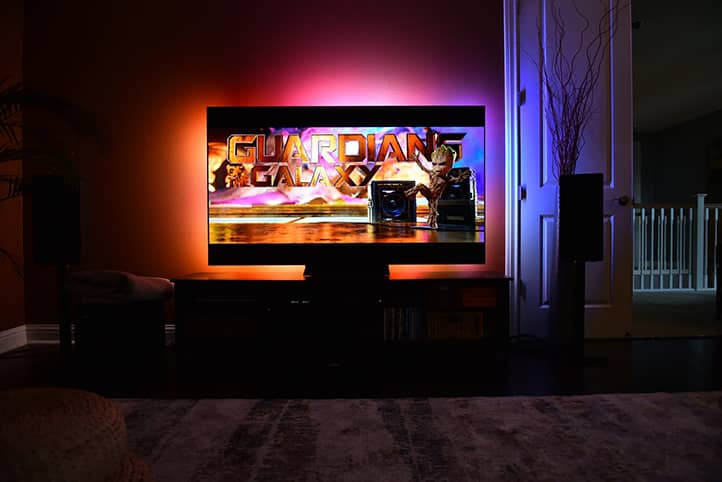
Potential Risks and How to Avoid Them
LED backlighting for TVs is a stylish and practical solution for creating a comfortable atmosphere. However, improper use may lead to some undesirable effects. Excessive brightness, incorrect color temperature settings, or abrupt color changes can cause irritation, fatigue, and even negatively affect the nervous system. To avoid these issues, it’s important to understand the main risks and follow recommendations to minimize them.
Let’s explore two key factors that can pose risks: excessive brightness and the impact of flickering or abrupt color changes. Understanding these factors and correctly adjusting the LED backlighting will help ensure safe and comfortable use.
Excessive Bright Light
Overly bright lighting is one of the primary causes of visual and psychological discomfort. Bright light increases the contrast between the TV screen and the surrounding environment, leading to eye strain. This is particularly concerning during prolonged movie watching or using backlighting in a dark room.
- Effects on Vision: Constant exposure to bright light forces the eyes to adapt to varying lighting levels, which can cause fatigue and even headaches.
- Emotional Strain: Overly intense light disrupts the harmony of spatial perception, creating a sense of unease.
How to Avoid:
- Adjust the brightness of the backlight so it does not exceed the brightness of the TV screen.
- Use dimmed tones in the evening to create a relaxing atmosphere.
- Opt for backlighting with brightness adjustment features to adapt it to different conditions.
Flickering and Abrupt Color Changes
Flickering or overly frequent color changes can cause discomfort, irritation, and even trigger stress reactions. For some individuals, this can be particularly bothersome and lead to a decline in overall well-being, including nervous agitation or loss of focus.
- Constant flickering can cause irritation, as the nervous system interprets such signals as a threat.
- Abrupt changes in bright colors can lead to fatigue, especially during dynamic scenes in movies or games.
How to Avoid:
- Avoid modes with frequent flickering, especially in low-light environments.
- Configure smooth transitions between colors to make the backlighting more natural and gentle on perception.
- Choose backlighting with an “anti-flicker” feature that prevents abrupt changes in light.
Example of Safe Usage
Suppose you want to watch a movie in the evening. Select a soft yellow or orange light with low brightness, avoid dynamic modes, and adjust the backlighting so it doesn’t distract from the screen. Remember, comfortable lighting should complement the overall ambiance harmoniously rather than compete with the TV’s visuals.
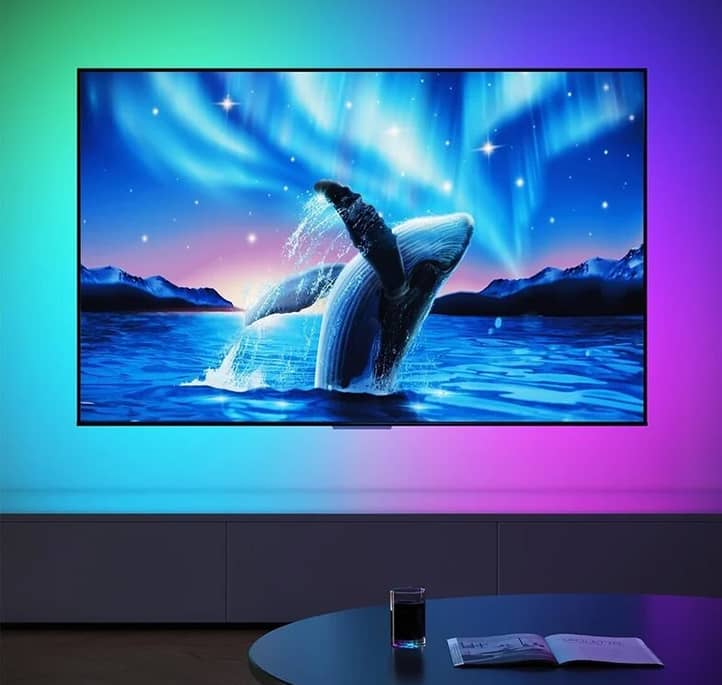
Conclusion
LED backlighting for TV is a powerful tool for creating a comfortable and harmonious atmosphere. Its use helps not only to improve the visual perception of the image on the screen, but also has a positive effect on the emotional state. Soft glow, correctly selected colors and thoughtful backlight settings create coziness, relieve stress and help to relax after a busy day.
Scientific research confirms that light and color scheme directly affect the psyche, shaping the mood and general condition. The use of warm shades promotes peace, and cold and neutral colors help to concentrate or create a calm atmosphere. LED backlighting allows you to adapt the space to any task, be it watching movies, evening meditation or active games.
However, it is important to remember that comfort consists of details. Excessive brightness or frequent flickering can cause fatigue, so you should pay attention to the correct backlight settings. Moderate brightness, smooth transitions between colors and the use of soft shades will provide not only visual comfort, but also harmony in the space.
When creating a home atmosphere, it is important to consider not only the technical parameters of the devices, but also their impact on the emotional state. LED lighting, when used correctly, becomes an important tool in creating a favorable environment that supports inspiration and internal balance.

